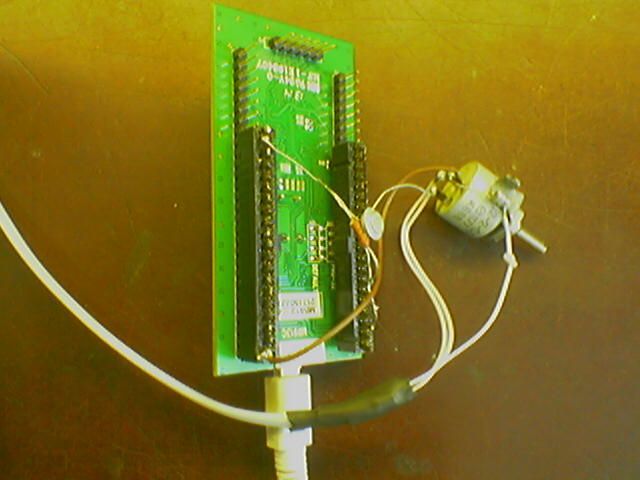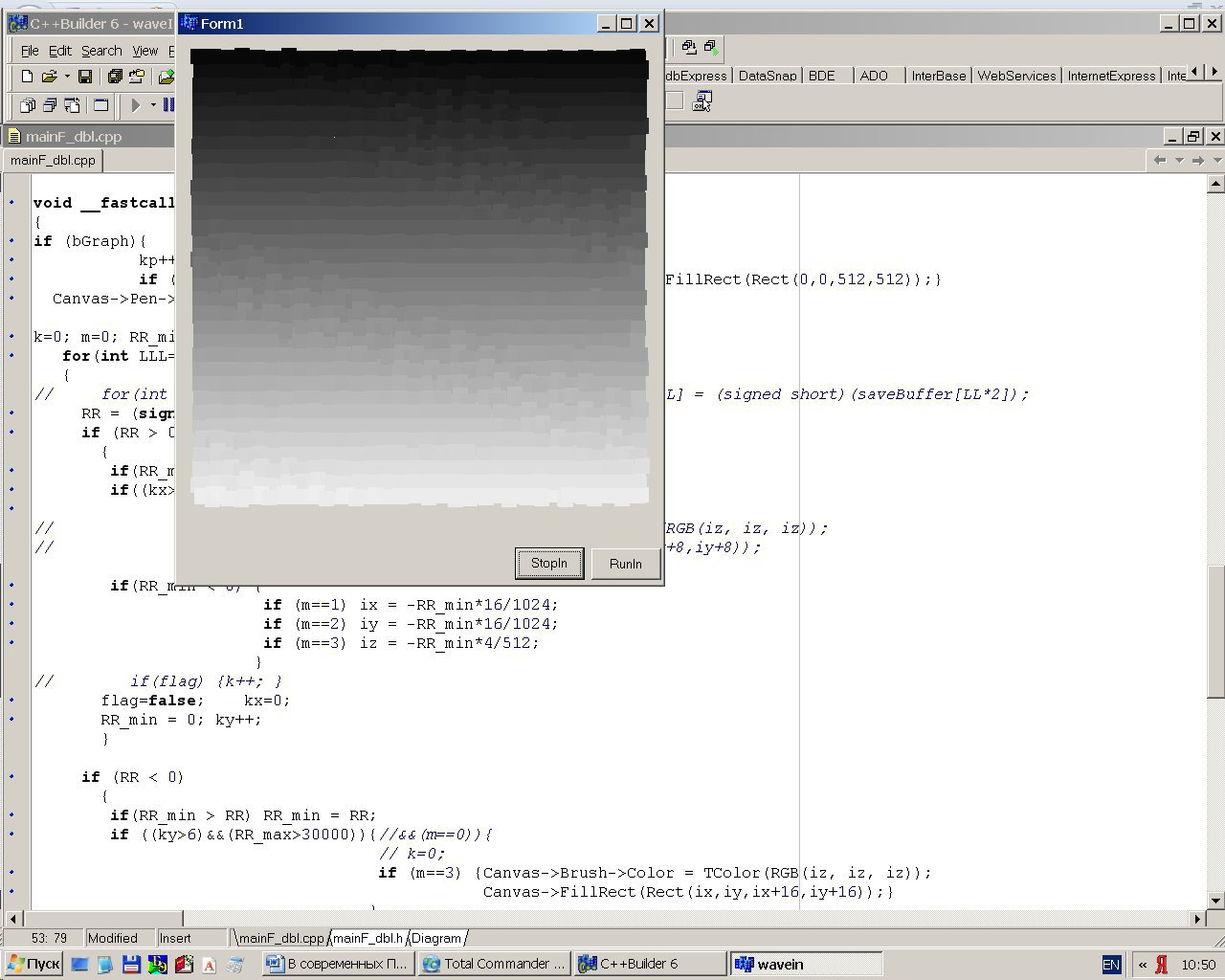Sound card as a serial port
In modern PCs, there is the lack of easy-to-use interfaces. To use USB, a large amount of complex code is required, and for UART you need a USB-COM adapter. If the external device is simple, then the development of the interface may take longer than the development of the device itself. At the same time, many devices have an analog interface for audio devices that can be used to input or output data without any modification. Here is an example of data input from the STM32VLDISCOVERY board on a PC running Windows XP through a microphone input. The interface is not purely digital, but digital-analog. Data from the board is transmitted in bursts of 4 rectangular pulses of different amplitudes through the DAC of the controller. The pulse repetition rate corresponds to the upper frequency of the input amplifier of most sound cards - 20 kHz. The beginning of the pack is marked by a double width pulse. The following 3 pulses carry information that is embedded in the amplitude of the pulse. The data transfer rate for 4-bit amplitude coding is approximately 45 kbps.
STM32VLDISCOVERY firmware code:
')
Application code on PC:
On the form there are 2 buttons “Stop” and “Run”, as well as a field of squares, whose position in x and y coordinates is determined by the amplitude of the first 2 pulses, and the brightness by the amplitude of the 3rd. The boards are connected with a telephone wire, from the PC side a standard jack for mono, from the STM32VLDISCOVERY side, the output of PA.04 connected via an emitter follower (in STM32VLDISCOVERY is a high-impedance DAC output) and a divider for calibration (variable resistor).

The test image transmitted to the PC via the microphone input from STM32VLDISCOVERY (32x32 square field with squares luminosity gradient from top to bottom):

STM32VLDISCOVERY firmware code:
#include "stm32f10x.h" #define DAC_DHR12RD_Address 0x40007420 #define BUF_SIZE 640 /* Init Structure definition */ DAC_InitTypeDef DAC_InitStructure; DMA_InitTypeDef DMA_InitStructure; TIM_TimeBaseInitTypeDef TIM_TimeBaseStructure; /* Private variables ---------------------------------------------------------*/ uint32_t DualSine12bit[BUF_SIZE], Idx = 0, Idx2 = 0, Idx3 = 0, a1,a2,a3,a4, cc; int RR; double R; /* Private function prototypes -----------------------------------------------*/ void RCC_Configuration(void) { /* DMA1 clock enable */ RCC_AHBPeriphClockCmd(RCC_AHBPeriph_DMA1, ENABLE); /* GPIOA Periph clock enable */ RCC_APB2PeriphClockCmd(RCC_APB2Periph_GPIOA, ENABLE); /* DAC Periph clock enable */ RCC_APB1PeriphClockCmd(RCC_APB1Periph_DAC, ENABLE); /* TIM2 Periph clock enable */ RCC_APB1PeriphClockCmd(RCC_APB1Periph_TIM2, ENABLE); } void GPIO_Configuration(void) { GPIO_InitTypeDef GPIO_InitStructure; GPIO_InitStructure.GPIO_Pin = GPIO_Pin_4 | GPIO_Pin_5; GPIO_InitStructure.GPIO_Mode = GPIO_Mode_AIN; GPIO_Init(GPIOA, &GPIO_InitStructure); } void Timebase_Configuration(void) { TIM_TimeBaseStructInit(&TIM_TimeBaseStructure); TIM_TimeBaseStructure.TIM_Period = 0x120; //0x04; 0x150; TIM_TimeBaseStructure.TIM_Prescaler = 0x01; TIM_TimeBaseStructure.TIM_ClockDivision = 0x0; TIM_TimeBaseStructure.TIM_CounterMode = TIM_CounterMode_Up; TIM_TimeBaseInit(TIM2, &TIM_TimeBaseStructure); /* TIM2 TRGO selection */ TIM_SelectOutputTrigger(TIM2, TIM_TRGOSource_Update); /* TIM2 enable counter */ TIM_Cmd(TIM2, ENABLE); } void DAC_Configuration() { /* DAC channel1 Configuration */ DAC_InitStructure.DAC_Trigger = DAC_Trigger_T2_TRGO; DAC_InitStructure.DAC_WaveGeneration = DAC_WaveGeneration_None; DAC_InitStructure.DAC_OutputBuffer = DAC_OutputBuffer_Disable; //Enable; DAC_Init(DAC_Channel_1, &DAC_InitStructure); /* DAC channel2 Configuration */ DAC_Init(DAC_Channel_2, &DAC_InitStructure); /* Enable DAC Channel1: Once the DAC channel1 is enabled, PA.04 is automatically connected to the DAC converter. */ DAC_Cmd(DAC_Channel_1, ENABLE); /* Enable DAC Channel2: Once the DAC channel2 is enabled, PA.05 is automatically connected to the DAC converter. */ DAC_Cmd(DAC_Channel_2, ENABLE); /* Enable DMA for DAC Channel2 */ DAC_DMACmd(DAC_Channel_2, ENABLE); } void DMA_Configuration() { /* DMA1 channel4 configuration */ DMA_DeInit(DMA1_Channel4); DMA_InitStructure.DMA_PeripheralBaseAddr = DAC_DHR12RD_Address; DMA_InitStructure.DMA_MemoryBaseAddr = (uint32_t)&DualSine12bit; DMA_InitStructure.DMA_DIR = DMA_DIR_PeripheralDST; DMA_InitStructure.DMA_BufferSize = BUF_SIZE; DMA_InitStructure.DMA_PeripheralInc = DMA_PeripheralInc_Disable; DMA_InitStructure.DMA_MemoryInc = DMA_MemoryInc_Enable; DMA_InitStructure.DMA_PeripheralDataSize = DMA_PeripheralDataSize_Word; DMA_InitStructure.DMA_MemoryDataSize = DMA_MemoryDataSize_Word; DMA_InitStructure.DMA_Mode = DMA_Mode_Circular; DMA_InitStructure.DMA_Priority = DMA_Priority_High; DMA_InitStructure.DMA_M2M = DMA_M2M_Disable; DMA_Init(DMA1_Channel4, &DMA_InitStructure); /* Enable DMA1 Channel4 */ DMA_Cmd(DMA1_Channel4, ENABLE); } void Delay(__IO uint32_t nCount) { for(; nCount != 0; nCount--); } void Point(uint32_t kx, uint32_t ky, uint32_t ki) { for (Idx2 = 0; Idx2 < BUF_SIZE-10; Idx2++) { DualSine12bit[Idx2+10] = DualSine12bit[Idx2]; } DualSine12bit[0] = 4095; DualSine12bit[1] = 4095; DualSine12bit[2] = 0; DualSine12bit[3] = 0; DualSine12bit[4] = 2096 + kx; DualSine12bit[5] = 2000 - kx; DualSine12bit[6] = 2096 + ky; DualSine12bit[7] = 2000 - ky; DualSine12bit[8] = 2096 + ki; DualSine12bit[9] = 2000 - ki; } /* Private functions ---------------------------------------------------------*/ int main(void) { /* System Clocks Configuration */ RCC_Configuration(); /* Once the DAC channel is enabled, the corresponding GPIO pin is automatically connected to the DAC converter. In order to avoid parasitic consumption, the GPIO pin should be configured in analog */ GPIO_Configuration(); /* TIM2 Configuration */ /* Time base configuration */ Timebase_Configuration(); /* DAC channel1 Configuration */ DAC_Configuration(); /* DMA1 channel4 configuration */ DMA_Configuration(); R = 1; RR=1; a1 = 2023; a2 = 1000; a3 = 100; a4 = 900; while (1) { for (Idx = 0; Idx < 32*32; Idx++) { Idx3 = Idx/32; Point((Idx-Idx3*32)*50,Idx3*50,Idx/32*50); } } } ')
Application code on PC:
#include <stdlib.h> #include <stdio.h> #include <conio.h> #include <string.h> #include <fstream.h> #include <iomanip.h> #include <windows.h> #include <math.h> #include <vcl.h> #include <mmsystem.h> #include "mainF_dbl.h" #pragma hdrstop #pragma package(smart_init) #pragma resource "*.dfm" #define INP_BUFFER_SIZE 16384 #define SAMPLE_RATE 192000 TForm1 *Form1; static HWAVEIN hWaveIn = NULL; static WAVEHDR WaveHdr1, WaveHdr2; static WAVEFORMATEX waveformat ; static unsigned short Buffer1[INP_BUFFER_SIZE], Buffer2[INP_BUFFER_SIZE], saveBuffer[INP_BUFFER_SIZE]; static signed int RR, saveBuffer2[INP_BUFFER_SIZE]; static BOOL bEnding, bGraph, flag; BOOL bShutOff; long int RR_max, RR_min, LLL; int ix, iy, iz, k, kx, ky, m, kp ; void CALLBACK waveInProc1(HWAVEIN hwi, UINT uMsg, DWORD dwInstance, DWORD dwParam1, DWORD dwParam2) { switch(uMsg) { case WIM_OPEN: break; case WIM_DATA: CopyMemory (saveBuffer, ((PWAVEHDR) dwParam1)->lpData, ((PWAVEHDR) dwParam1)->dwBytesRecorded) ; if (bEnding){ waveInReset (hWaveIn); waveInClose (hWaveIn); return; } waveInAddBuffer (hwi, (PWAVEHDR) dwParam1, sizeof (WAVEHDR)) ; // Send out a new buffer break; case WIM_CLOSE: waveInUnprepareHeader (hWaveIn, &WaveHdr1, sizeof (WAVEHDR)) ; waveInUnprepareHeader (hWaveIn, &WaveHdr2, sizeof (WAVEHDR)) ; } } //xxxxxxxxxxxxxxxxxxxxxxxxxxxxxxxxxxxxxxxxxxxxxxxxxxxxxxx void __fastcall TForm1::startButtonClick(TObject *Sender) { bGraph=false; } //xxxxxxxxxxxxxxxxxxxxxxxxxxxxxxxxxxxxxxxxxxxxxxxxxxxxxxx void __fastcall TForm1::formDestroy(TObject *Sender) { bEnding=false; } //xxxxxxxxxxxxxxxxxxxxxxxxxxxxxxxxxxxxxxxxxxxxxxxxxxxxxxx void __fastcall TForm1::Button1Click(TObject *Sender) { bGraph=true; } //xxxxxxxxxxxxxxxxxxxxxxxxxxxxxxxxxxxxxxxxxxxxxxxxxxxxxxx __fastcall TForm1::TForm1(TComponent* Owner) : TForm(Owner) { waveformat.wFormatTag = WAVE_FORMAT_PCM ; waveformat.nChannels = 1; //2 ; waveformat.wBitsPerSample = 16 ; waveformat.nSamplesPerSec = SAMPLE_RATE ; waveformat.nBlockAlign = waveformat.nChannels * (waveformat.wBitsPerSample / 8); waveformat.nAvgBytesPerSec = waveformat.nBlockAlign * waveformat.nSamplesPerSec; waveformat.cbSize = 0 ; if (waveInOpen (&hWaveIn, WAVE_MAPPER, &waveformat, (DWORD)waveInProc1, 0, CALLBACK_FUNCTION)){ Application->MessageBox( "000000000","Error",MB_OK ); return; } bShutOff=false; // Set up headers and prepare them WaveHdr1.lpData = (BYTE *)Buffer1 ; WaveHdr1.dwBufferLength = INP_BUFFER_SIZE*2 ; // WaveHdr1.dwBytesRecorded = 0 ; WaveHdr1.dwUser = 0 ; WaveHdr1.dwFlags = 0 ; WaveHdr1.dwLoops = 1 ; WaveHdr1.lpNext = NULL ; WaveHdr1.reserved = 0 ; waveInPrepareHeader (hWaveIn, &WaveHdr1, sizeof (WAVEHDR)) ; WaveHdr2.lpData = (BYTE *)Buffer2 ; WaveHdr2.dwBufferLength = INP_BUFFER_SIZE*2 ; // WaveHdr2.dwBytesRecorded = 0 ; WaveHdr2.dwUser = 0 ; WaveHdr2.dwFlags = 0 ; WaveHdr2.dwLoops = 1 ; WaveHdr2.lpNext = NULL ; WaveHdr2.reserved = 0 ; waveInPrepareHeader (hWaveIn, &WaveHdr2, sizeof (WAVEHDR)) ; waveInAddBuffer (hWaveIn, &WaveHdr1, sizeof (WAVEHDR)) ; waveInAddBuffer (hWaveIn, &WaveHdr2, sizeof (WAVEHDR)) ; waveInStart (hWaveIn) ; bGraph=true; bEnding = FALSE; } void __fastcall TForm1::Timer1Timer(TObject *Sender) { if (bGraph){ kp++; if (kp>20){kp=0; Canvas->Brush->Color = Color; Canvas->FillRect(Rect(0,0,512,512));} k=0; m=0; RR_min=0; RR_max=0; kx=0; ky=0; for(int LLL=0; LLL<INP_BUFFER_SIZE; LLL++) { short)(saveBuffer[LL*2]); RR = (signed short)(saveBuffer[LLL]); if (RR > 0) { if(RR_max < RR) RR_max = RR; if((kx>6)&&(RR_min<30000)) { //&&(k==0)){ m=0; } if(RR_min < 0) { if (m==1) ix = -RR_min*16/1024; if (m==2) iy = -RR_min*16/1024; if (m==3) iz = -RR_min*4/512; } flag=false; kx=0; RR_min = 0; ky++; } if (RR < 0) { if(RR_min > RR) RR_min = RR; if (ky>6){ if (m==3) {Canvas->Brush->Color = TColor(RGB(iz, iz, iz)); Canvas->FillRect(Rect(ix,iy,ix+16,iy+16));} } if(!flag) m++; RR_max = 0; flag=true; ky=0; kx++; } } } } On the form there are 2 buttons “Stop” and “Run”, as well as a field of squares, whose position in x and y coordinates is determined by the amplitude of the first 2 pulses, and the brightness by the amplitude of the 3rd. The boards are connected with a telephone wire, from the PC side a standard jack for mono, from the STM32VLDISCOVERY side, the output of PA.04 connected via an emitter follower (in STM32VLDISCOVERY is a high-impedance DAC output) and a divider for calibration (variable resistor).

The test image transmitted to the PC via the microphone input from STM32VLDISCOVERY (32x32 square field with squares luminosity gradient from top to bottom):

Source: https://habr.com/ru/post/224169/
All Articles